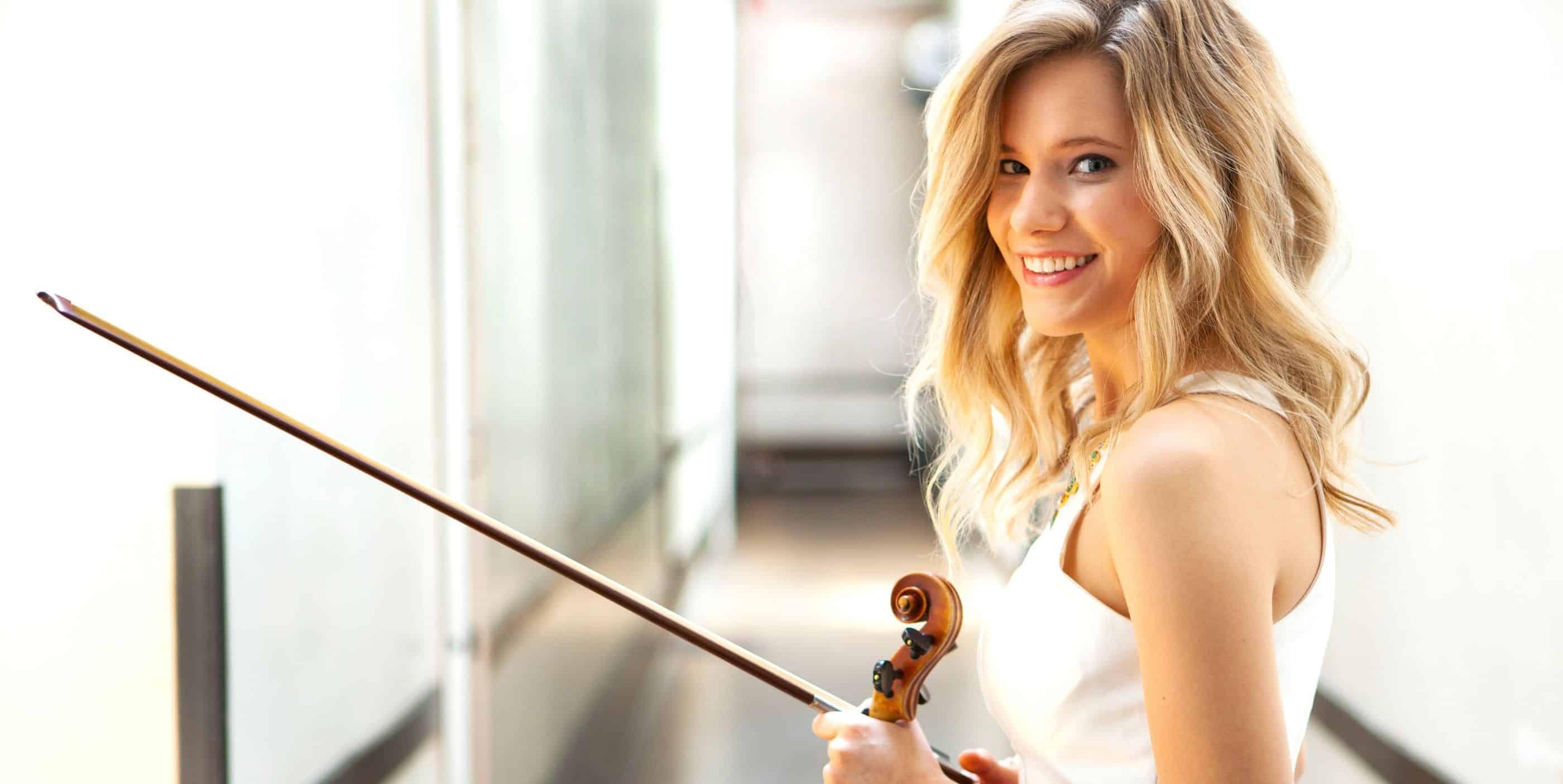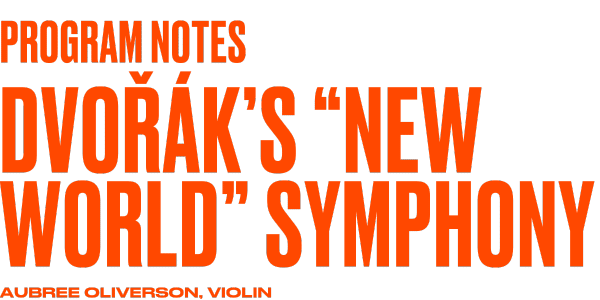DVOŘÁK: Symphony No. 9 “From the New World”
THE COMPOSER – ANTONÍN DVOŘÁK (1841-1904) – In the last years of the 1890, Dvořák again began to look beyond Prague and entertain lucrative offers from abroad. There were trips to Moscow and St. Petersburg on the invitation of Tchaikovsky and a visit to England in 1890 for concerts and honorary degrees. One year later, Dvořák was offered a position at the National Conservatory of Music in New York. America was country already greatly enamored of his music and the Conservatory leaders were intensely interested in his nationalistic voice as an artist. In a country without its own established musical identity, his example could have a powerful effect. Dvořák was fully aware of this hope and took the desires of his hosts quite seriously.
THE HISTORY – Two months after his arrival in the States, Dvořák wrote to a friend, “The Americans expect great things from me,” adding, “I am to show them a way into…the realm of a new, independent art.” Hardly daunted, he was inspired by their faith in him and immediately sought out samples of American folk idioms. Dvořák found a wealth of possibility in the spirituals of the African American tradition as well as the culture of the continent’s Native people. He believed the future of American music to be dependent on these two sources, that they were a “product of the soil” and that young composers should turn always to them if they wished to “express the true sentiment of [their] people.” The heartfelt Symphony No. 9 (1893) grew out of this fascination and created a representation of the “New World” that hardly seemed possible from the pen of a guest, even a pen as talented as Dvořák’s. Many of the themes in the symphony appeared to be direct folk quotations but Dvořák was insistent that he crafted them from scratch, using his deep study of our indigenous melodies as a guide. His distillations of our heritage were so natural that, even today with the benefit of research and scholarship, this can be difficult to accept. The finest example of this disbelief comes from the Symphony’s famous Largo movement and the music we now know familiarly as “Goin’ Home.” Though it is easy to imagine this as a pre-existing Negro Spiritual, Dvořák did create it from whole cloth, and the words were added later by William Arms Fisher. Whatever the provenance of this and other “source” material, Dvořák gifted America with a masterpiece, one that delighted in the charms of our nation and celebrated its unique musical soul. That our own composers would, over the ensuing half century, ignore his advice in favor of larger European trends and fashions, was not the fault of this humble and earnest Czech visitor.
THE WORLD – Elsewhere in 1893, the World’s Fair was held in Chicago, the first ever vehicle license plates were issued in Paris, the Hawaiian monarchy fell and Oscar Wilde’s controversial play Salome was published.
THE CONNECTION – The last Utah Symphony performance of the very popular “New World” Symphony was in 2019. Thierry Fischer was on the podium.
BARBER: Violin Concerto
THE COMPOSER – SAMUEL BARBER (1910-1981) – Barber is more beloved today than he was during his compositional heyday in the 1930s, ‘40s and ‘50s. It happens to many composers who are either ahead of or behind their time. Barber won two Pulitzer Prizes and earned commissions from prestigious soloists and orchestras, but his output was judged by many as hopelessly antique and out of touch. His lyrical, neo-Romantic voice stood at odds with the strong currents of contemporary European experimentalism at work on the American scene at the time. Ironically, many of the scores Barber produced during this period have had a longer life than any of the more adventurous works they were judged against.
THE HISTORY – First among these enduring contributions to the “American” sound was the Violin Concerto. It was commissioned by the wealthy soap magnate (yes, soap) Samuel Fels for the young Russian-born violinist Iso Briselli. Barber began writing the music in Switzerland and continued work in Paris before being forced to rush home ahead of the coming war in 1939. The “story” of this concerto did not become less interesting when it reached American soil. Accounts as to why vary predictably, but the fact remains that Briselli declined to perform the premiere in 1941. The infamous debate between composer and dedicatee centered on the concerto’s daredevil third movement. Some (Barber’s first biographer Nathan Broder, notably) say that Briselli told Barber the movement was unplayable while others assert that Briselli said he objected to it as unworthy of the of the concerto’s first two movements. Current scholarship bolsters the word of the soloist and, while nobody can irrefutably confirm what he did or didn’t say to the composer in private, it holds up that his objections were artistic rather than technical. In fact, it makes sense for two clear reasons. One, the finale was in fact “playable,” as Albert Spalding soon proved at the 1941 premiere. And two, most importantly, the frantic third movement does stand apart from the more poetic first two, giving the concerto a bit of an ambivalent temperament. Regardless, Barber was unwilling to change the ending, and Briselli gave up his performance rights. The celebrated violinist never changed his mind about the piece and, even when public opinion about the music eventually left him in the cold, he avoided playing it for the duration of his long life. Final analysis: who cares? Once the magical opening theme of the opening movement unfolds, all sins – real and imagined, once and future – are forgiven.
THE WORLD – Elsewhere in 1941, the world was at war (though America did not officially engage until that December), polyester fiber was invented in Britain, Germany abandoned “Blackletter” (Gothic) script in favor of Roman and James Joyce passed away.
THE CONNECTION – Utah Symphony last performed Barber’s Violin Concerto during the 2016-17 season. Jun Märkl was on the podium and Karen Gomyo appeared as soloist.
RAVEL: Boléro
THE COMPOSER – MAURICE RAVEL (1875-1937) – Ravel did quite a bit of touring in 1920s and 1930s. The successes he enjoyed on the road made a very good impression at home even though, as always, he maintained a cool indifference to the evolving critical opinion of his countrymen. He visited Britain, two countries in Scandinavia, Spain, Italy and Austria. One of his most productive trips was a four-month swing through America and Canada in 1928. In addition to visiting Niagara Falls, peering into the Grand Canyon and meeting Douglas Fairbanks (which whom he reportedly conversed in French), Ravel’s itinerary included several highly visible interviews and lecture appearances where he was particularly keen to discuss his fascination with American jazz and the blues.
THE HISTORY – Like Stravinsky, Ravel was commissioned in 1928 by the dancer/impresario Ida Rubenstein to compose a work for her new ballet company. Rubenstein had performed to great acclaim (despite her unorthodox, self-taught style) in Diaghilev’s Ballet Russes before deciding that, with her vast inherited wealth and natural skills as a promoter, she should start her own troupe. For Ravel’s commission, Rubenstein was specifically interested in music with a “Spanish” flair. The composer was no stranger to this kind of sound, having been born to a Basque mother, but he proposed an orchestration of several sections of Isaac Albéniz’s Iberia instead of an original piece. Unfortunately (for him, not us), the rights to the Albéniz score had already been claimed, which left Ravel with a bit of a problem. He now had to create a ballet movement from scratch and, with Rubenstein’s deadline approaching, he hadn’t left himself enough time to do it. The brilliant solution Ravel devised to solve this dilemma yielded one of symphonic music’s greatest hits. A single beguiling theme is introduced in its purest form and then simply repeated in one increasingly ingenious 13-minute crescendo. There has never been anything quite like it, before or since, and only the last seconds hint at the possibility of a harrowing undercurrent to this monotone masterpiece. It is impossible to know for sure whether composers, when they complete a new score, know that they have struck public gold. Most of them feign surprise or even frustration with their most famous creations. Ravel, for his part, was ambivalent about the popularity, but clear about his intentions. “[Boléro] constitutes an experiment in a very special and limited direction and should not be suspected of aiming at achieving anything other or more than it actually does,” he wrote, “I have carried out exactly what I intended, and it is for the listener to take it or leave it.” There’s that indifference again.
THE WORLD – Elsewhere in 1928, the Winter Olympic Games were held in St. Moritz with the Summer Games in Amsterdam, the first radio broadcast of the controversial nightly serial Amos ‘n’ Andy aired and .
THE CONNECTION – Boléro has performed often by the Utah Symphony on various concerts. The most recent Masterworks presentation was in 2018 under Jun Märkl.
by Jeff Counts





